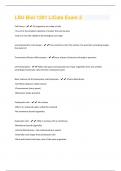Microscopes and cells Study guides, Class notes & Summaries
Looking for the best study guides, study notes and summaries about Microscopes and cells? On this page you'll find 665 study documents about Microscopes and cells.
Page 4 out of 665 results
Sort by

-
Brooks Biological Principles Exam 2 Latest Update with Verified Solutions
- Exam (elaborations) • 38 pages • 2024
- Available in package deal
-
- $10.99
- + learn more
Brooks Biological Principles Exam 2 Latest Update with Verified Solutions Cytology the study of cells Cell Theory all living things are composed of cells and come from living cells Robert Hooke one of the first to use microscope, observing a piece of cork from the stem of plants, where he found chambers arising in the idea of a cell. Light Microscope takes pictures of large atoms. nucleus, not electrons Scanning Electron Microscope electrons are reflected off of a specimen and ...

-
Combined Science Higher Biology GCSE 9-1 AQA Flashcards Graded A+
- Exam (elaborations) • 101 pages • 2024
- Available in package deal
-
- $9.49
- + learn more
Combined Science Higher Biology GCSE 9-1 AQA Flashcards Graded A+ What is a cell? ️The basic unit of all living things What is a eukaryotic cell? ️A cell with a nucleus What is a prokaryotic cell? ️A cell without a nucleus Features of a eukaryotic cell? ️- Have a membrane bound nucleus - Large (10 - 100 µm) - Multi cellular - Complex Features of a prokaryotic cell? ️- Lacks a nucleus - Small (0.1 - 5 µm) - Unicellular - Simple Example of prokaryotic cell... ️Bacteria ...

-
AQA GCSE Combined Science Trilogy : Biology Paper 1
- Exam (elaborations) • 33 pages • 2024
- Available in package deal
-
- $10.49
- + learn more
AQA GCSE Combined Science Trilogy : Biology Paper 1 Name the two types of cells Prokaryotic and Eukaryotic What is a prokaryotic cell? A cell without a nucleus Give an example of a prokaryote (Prokaryotic cell) Bacteria What is a eukaryotic cell? cell with a nucleus Give two examples of eukaryotic cells Plant & Animal cells What three sub-cellular structures do plant cells have which animal cells do not? Permanent vacuole, cell wall and chloroplasts What is the function of the nu...

-
General Botany - Exam 1 Questions & Answers 2024/2025
- Exam (elaborations) • 10 pages • 2024
- Available in package deal
-
- $8.49
- + learn more
General Botany - Exam 1 Questions & Answers 2024/2025 Robert Cook - ANSWERSscientist who discovered cells from a cork and called them cellula (1665) Cell Theory - ANSWERS1. All living organisms are composed of one or more cells. 2. The cell is the basic unit of structure and organization in organisms. 3. Cells arise from pre-existing cells. Two types of microscopes - ANSWERScompound and dissecting Eukaryote - ANSWERSA cell that contains a nucleus, membrane bound organelles, and l...

-
2022 AQA GCSE Biology Paper 1
- Exam (elaborations) • 29 pages • 2023
-
- $15.49
- + learn more
2022 AQA GCSE Biology Paper 1. What are the two types of cells? - Answer - ● Eukaryotic (plant and animal) ● Prokaryotic (bacteria) What are the differences between eukaryotic and prokaryotic cells? - Answer - Prokaryotic cells are much smaller than eukaryotic cells. Eukaryotic cells contain membrane bound-organelles and a nucleus containing genetic material, while prokaryotes do not. How is genetic information stored in a prokaryotic cell? - Answer - Found free within the cytoplasm a...

-
BIOS 242 Lab 3: Microscopy- Observation of Cells
- Other • 11 pages • 2023
-
- $19.49
- + learn more
Lab 3: Microscopy- Observation of Cells Learning Objectives: Use the compound light microscope for observation of cells. Identify different types of bacteria based on their shapes. Identify a variety of eukaryotic cells. VIDEOS: a) How to Use a Compound Microscope (Elon TLT) b) Parts of the Compound Microscope (Tami Guy) Introduction: Microbiology is the study of organisms, which cannot be seen with naked eye. You will need help of a microscope to observe these “tiny anim...

-
Microbes & Society - Final Exam Study || A+ Guaranteed.
- Exam (elaborations) • 40 pages • 2024
- Available in package deal
-
- $16.49
- + learn more
Hooke - Mid 1600s correct answers - Credit for coining term "cell" - One of the first microscope users Anton Van Leeuwenhoek - Late 1600s correct answers - Lens manufacturing for microscopes - Made the first, real microscope *Animalcules in drops of water ---> really just protozoa *Wrote letters to Royal Society on findings *Discovers true cells in yeast and sperm Edd Jenner - Late 1700s correct answers - First to figure out vaccines - Made vaccine for smallpox ---> made from...

-
Bio 1P91 Midterm October Verified Questions & Correct Answers | Expert- Solutions | Latests update
- Exam (elaborations) • 26 pages • 2023
- Available in package deal
-
- $11.84
- + learn more
Bio 1P91 Midterm October Verified Questions & Correct Answers | Expert- Solutions | Latests update elements of the scientific method - ANSWER characterization, generate hypothesis, experimentation, intemperate results an accepted hypothesis is aka - ANSWER theory Law or principal - ANSWER Accepted by overwhelming majority of scientists What do e- shells represent - ANSWER Energy state of an atom In water ionic bonds - ANSWER Dissociate Types of bonds - ANSWER Ionic, covalent, H bo...

-
LSU Biol 1201 LiCata Exam 2 Questions and Answers with complete solution
- Exam (elaborations) • 15 pages • 2023
- Available in package deal
-
- $8.49
- + learn more
Cell theory - -All organisms are made of cells -The cell is the simplest collection of matter that can be alive -Cells are near the middle of the biological size range scanning electron microscope - Focus electrons onto the surface of a specimen, providing images that look 3-D Transmission Electron Microscopes - focus a beam of electrons through a specimen cell fractionation - Takes cells apart and separates the major organelles from one another centrifuges fractionate cells into their co...

-
IB BIO 1ST SEMESTER EXAM- UNIT TEST QUESTIONS
- Exam (elaborations) • 7 pages • 2024
-
- $11.49
- + learn more
Brain cells and bacterial cells are different in many ways. However, which of the following is something they must have in common? - Answer-Both must be a descendent of another cell What is a reason why viruses are not considered alive? - Answer-They are not made of cells Which of the following statements are true about the structure of cells? - Answer-I. All cells contain cytoplasm enclosed by the plasma membrane II. The microscope was important in understanding the structure of the cel...



